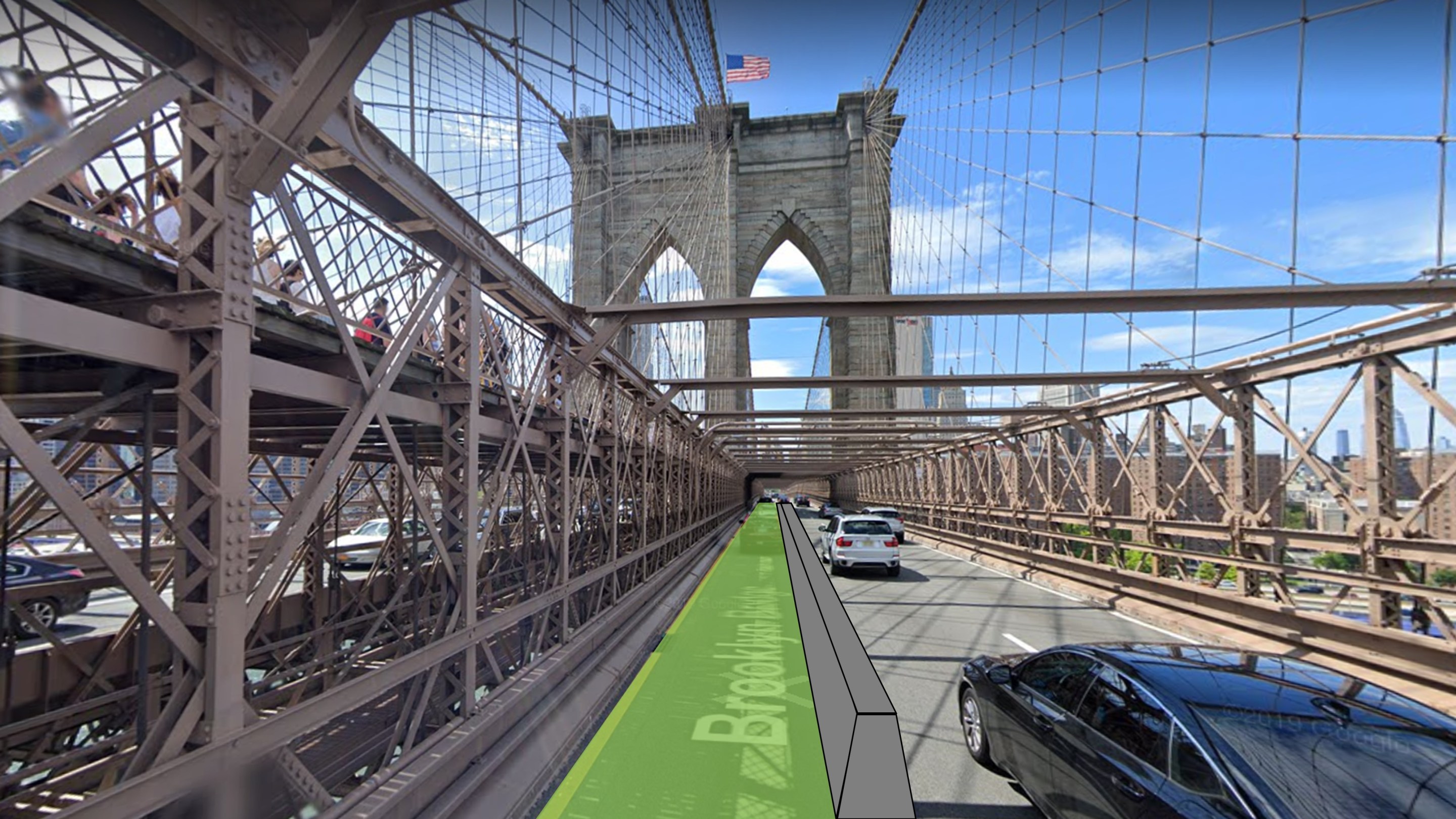The East River bridges allot vehicles 30 lanes to drive in or out of Manhattan, at no charge. That number is set to shrink by two, to 28, if Mayor de Blasio and his successor follow through on Thursday's announced conversions of one lane of traffic on the Brooklyn and Queensboro bridges.
Right on cue, though, one loud car guy cried foul. Queens Assembly member David Weprin complained to the New York Times, “There are still plenty of people who drive into Manhattan as well as small businesses who rely on those bridges. [Traffic congestion on the bridges] certainly will be an issue once the city comes back.”
Fear not, Member Weprin, a solution awaits: congestion pricing.
Tolling all four East River bridges — an integral part of congestion pricing — will shrink traffic volumes as some single-occupant auto trips switch to transit or carpool or bike ... or to an under-utilized East River tunnel or non-Manhattan destination. My modeling indicates that the reductions will average 20 percent (see note at the end of this story).
(That figure could eventually swell to nearly 35 percent as subway service improvements financed with the toll revenues lure more trips out of cars; but this will require keeping NYC Transit’s looming operating deficits from swallowing the money.)

Simple math suggests, then, that congestion pricing will easily take care of any traffic bunching from assigning one westbound Brooklyn Bridge lane and one eastbound Queensboro Bridge lane to cycling. Whatever bottlenecks exist now — or existed, pre-pandemic — on 30 lanes should remain unchanged if vehicle volumes and vehicle lanes both contract by 20 percent. This suggests that six lanes (20 percent of the existing 30) could be repurposed without slowing vehicles on the bridges, making it no sweat to re-assign just two, as the mayor has proposed.
This isn’t to say the auto-to-bike lane conversions have to wait on congestion pricing. Vehicle volumes entering the Manhattan core remain down and aren’t expected to rebound fully for some time. Moreover, as traffic guru “Gridlock Sam” Schwartz has been saying for years, simple equity demands rebalancing car lanes with bike lanes.
Schwartz counts 44 total vehicle lanes across the East River to and from Manhattan — tallying the Brooklyn-Battery and Queens-Midtown tunnels along with the East River bridges. He contrasts that with just two dedicated bike lanes, along with two shared with pedestrians and one, on the Manhattan Bridge, for pedestrians alone.
The mayor’s proposed conversions thus change the 44-2-2-1 balance of auto/shared bike-ped/bike only/and ped only lanes to 42-0-4-3. Not a seismic shift for drivers, but a big one for cyclists.
Thus far, coverage of the mayor’s announcement has centered on its boon to cycling, including the prospect that the Brooklyn Bridge, virtually unrideable most times from the crush of sightseers and other walkers, could again serve as a robust cycling span.
That change is a huge win for pedestrians, as well. Whether commuting on foot or out for a stroll, pedestrians shouldn’t have to maintain the level of vigilance that is de rigeur for cycling. Even so, on my own admittedly rare ventures onto the Brooklyn Bridge in recent years, I’ve consistently witnessed 99 percent or better pedestrian adherence to the (substandard) lane demarcation.

I’m looking forward not just to safer and faster outbound cycling on the QBB and inbound on the Brooklyn, but also to seeing walkers from Paris and Prospect Heights, from Bogota and Bedford-Stuyvesant, enjoying our iconic Brooklyn Bridge without fretting over where not to step. Let’s keep that in mind as we kvetch over — and fight to expand — the space we cyclists will soon have as our own on both those bridges.
As for Assembly Member Weprin, our advice is unchanged from two years ago when he so vehemently opposed congestion pricing: If congestion-free roads are your goal, get on board with the congestion toll!
Calculations of 20- to 35-percent reductions in bridge volumes from congestion pricing assume pre-pandemic traffic patterns as modeled in author’s BTA spreadsheet (downloadable Excel file). Make sure it is running “Fix NYC Komanoff prediction,” which includes $13 peak, $4 off-peak CBD toll (inbound only). Volume reduction figure of nearly 35 percent is complement of 0.656 output in Approaches tab, Cell K232. That reflects transit “attraction” from better subway service. To zero that out, go to Policy Levers tab and set Cells H206 and H209 to zero; Cell K232 then becomes 0.802, indicating 20 percent reduction.






